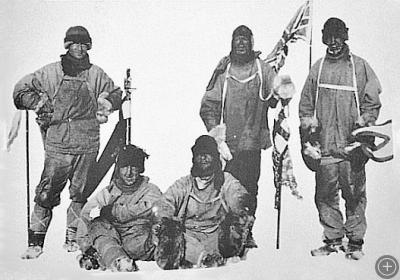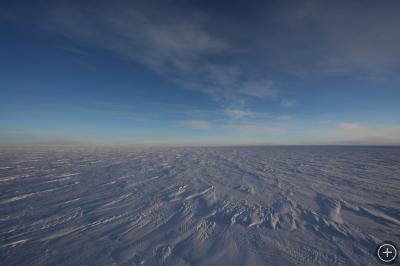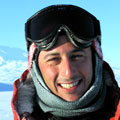Standing on Ye Shoulders of Giants
October 9, 2008
CHRISTCHURCH, NEW ZEALAND– “If I have seen further it is by standing on ye shoulders of Giants.” -Sir Isaac Newton
There is a long and rich history of Terra Incognita. The place names identifying scientific research bases, mountain tops, nunataks, valleys, glaciers, ice shelves, peninsulas, the surrounding oceans, and all of the conceivable minutia one can find on any map of the most inhospitable continent in the world barely scrape the frozen surface of understanding the breadth, scope, hardships, achievements, and contributions of those who have come before. One must dig a little deeper to appreciate the fullness of what Antarctica once was, how it became a frontier of exploration, what it means to the body of scientific research, and how further study will aid in our understanding– not only of past global climate, but of our future and how we as a human race will need to adapt in this time of prominent climate change.
I have read many of the classic tales of the Golden Age of Exploration. Each one of the first-person narratives, from Shackleton’s South, Amundsen’s Race to the South Pole, Scott’s personal journals, Cherry-Garrard’s The Worst Journey in the World, to the biographical sketches of Reginal Pound’s Scott of the Antarctic, Roland Huntsford’s The Last Place on Earth and Shackleton, and so many others, all convey the severe hardship that these men went through in the name of science and discovery. What comes across is that personal notoriety and accolade was not the motivation. Pushing the envelope of human understanding, furthering the knowledge base of the surrounding world, and broadening the global perspective all drove these men to reach deep within themselves to set out to achieve the unimaginable.

Robert Falcon Scott’s expedition, having reached the South Pole, January 18th, 1912. None in this party would survive the journey back.
Although Finnesko boots [made of reindeer fur] have been replaced with “bunny boots” [manufactured with wool and synthetics], reindeer clothing with ECW (extreme cold weather) gear, pemmican [meat-fat, a high-energy emergency food supply] with a well balanced varied diet, dog sleds and man-hauling for helicopters and snowmobiles — my motivation for journeying to the Antarctic is in parallel with those who have come before me. Climate change is one of the foremost issues facing the global community today. As an Earth scientist, I feel a responsibility to take an active role in furthering our understanding of this complex system. To be able to predict future climate change, I have to know the climate of the distant past, I have to be able to understand how the Earth’s climate changed through time to the conditions we live in today. To do that, I must go to Antarctica!
As I am on the brink of becoming a Polar explorer, I am so excited to have this opportunity. I feel very fortunate to be given this chance to go to the Ice. It is my hope that our ONH Team will locate sediments of the “Greenhouse World,” and that they will later be sampled and studied, not only to understand the global transition to the “Icehouse World” we live in today, but also to better gauge our future global climate.
As Antarctic explorer Apsley Cherry-Garrard said, “Courage, or ambition, or love of notoriety, may take you to the Antarctic, or any other uncomfortable place in the world, but it won’t take you far inside without being found out; it’s courage: and unselfishness: and helping one another: and sound condition; and willingness to put in every ounce you have: and clean living: and good temper: and tact: and good judgement: and faith. And the greatest of these is faith, especially a faith that what you are doing is of use.”












Good on you, Howie! I hope your work helps us figure out how to slow down (if not ever completely undo) these global transitions and climate changes. Be safe, stay warm, and don’t lose ye long johns.
Wow Howie…I can’t believe you’re really there! Good luck with all of your work, stay warm, and wear sunscreen!
Hello Mr. Koss,
We are studying Antarctica and are following your dispatches. We have some questions for you. What types of clothing did you need to take down to Antarctica with you? What kinds of things did you have to take with you for your time there? Do you have a wife and kids, and if so, how do they feel about you going away to such a dangerous and inhospitable environment? We look forward to hearing from you.
Mrs. Hutchins’s World Explorations Class
Good questions Mrs. Hutchins’s 6th grade class! Thanks, it’s always good to hear from people back home, and I’m glad you all are showing so much interest.
The clothing we have been issued to wear while down in Antarctica are called Extreme Cold Weather Gear, or ECW for short. The most notable and recognizable of these is the “Big Red,” a big Canadian goose down jacket that is the toastiest thing around. It has so many pockets for storage, that it weighs a ton by the time I’m ready to head into the field. I keep snacks, hand warmers, gloves, pens and pencils, my camera, a notebook, and a water bottle close at hand. The other articles of clothing include the “Bunny Boots,” wind pants, balaclava to cover the head and face, and of course long johns and wool socks! Check out my “Geared Up and Ready To Fly” blog for some photos of me trying on my gear.
I am married, and my wife and I do not have any children. My wife has been very supportive of my involvement in this project, and to her I’m incredibly thankful because I wouldn’t be able to be here if it weren’t for her. She knows that it has been a dream of mine to travel to Antarctica to be a part of a research expedition. At the same time the separation for so long is the hardest thing for her. She must go on with her day-to-day life that would normally include me without me. She’s not so worried about the extreme environment. She knows that we’ve received the training we need to work safely down here and that we all check on each other as part of our protocol (radio check-ins while we’re in the field, for example). Something a colleague of mine who had been down to Antarctica twice before I came this year told me to “play by the rules and nothing bad will happen.” These are words I live by down here. She knows I’m safe.
I’m looking forward to your further questions.
All the best for now from the Ice,
-Howie
Greetings, Howie!
Thank goodness there are people like you and your team mates to carry out the tough stuff, on behalf of the rest of us. Thank you for your sacrifices..
I am based in Invercargill – I work at the Southland Hospital Operating Theatres as an Anaesthetic Technician, been doing the same medical team stuff for 20 yrs (Soldier and Civilian). I am interested in the concept of large deposits of methane gas trapped in ancient ice – is this a reality and if so, what are the consequences of introducing this into our atmosphere (if any) ? There are so many things we (the general public) don’t appreciate.
Keep safe and know that your work is appreciated by all of us.
Kind regards
Stuart